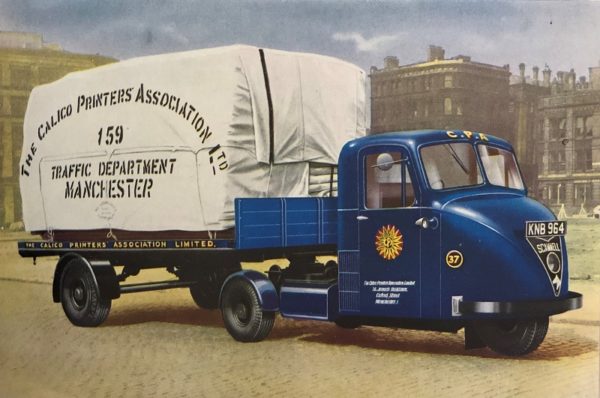
The location of this colourised picture from 1950 looks very much like Piccadilly Gardens in Manchester – which would not be surprise, because the Calico Printers’ Association Limited was based just down the road at St James’s Buildings in Oxford Street, as can just be detected in the script on the door of this Scammell Scarab.
Scammell made this workhorse of British manufacturing and transport industries between 1948 and 1967. It was a successor to the Scammell Mechanical Horse, conceived in the early 1930s by Napier & Son at the request of the London and North Eastern Railway to replace horses for local haulage purposes, while retaining the flexibility of changing wagons and the excellent manoeuvrability of a horse and wagon.
In 1933 Scammell Lorries Ltd purchased the design from Napier and took advantage of the refinements introduced at that time by Oliver Danson North. The Mechanical Horse had automatic trailer coupling and a single front wheel that could be steered through 360 degrees.
The Scammell Scarab kept all the advantages of the Mechanical Horse in a more modern shape. It was commonly believed to be named after the rounded bonnet that resembled the wing covers of a scarab beetle, but this is not so: it was a combination of the name Scammell and the Arab horses that were originally replaced by the Mechanical Horse. Scammell advertising gave this explanation.
The Scarab was very popular with all the railways that merged in 1948 to form British Railways, and with the military too: the Ministry of Defence used it with trailers for internal transport on large military bases.
The Scarab used the Scammell 2,090 cc side-valve engine in both the three- and six-ton versions, and a Perkins-engined diesel version was also produced. Never missing a trick in keeping costs low, Scammell pressed the roof and windscreen panels from steel using tools obtained from Bedford that originally made their ‘O’ type lorry. The engine was mounted lower and more centrally than in the Mechanical Horse and made the Scarab a much more stable machine, thus cementing its popularity with any business that operated in tight locations, especially in city environments.
The Scarab was replaced in 1967 by the Townsman that featured a fibreglass cab, designed by Giovanni Michelotti.
And not only a famous Italian designer enters the history of the Scammell. The “FAR” was made under licence by Chenard-Walcker and used the Citroën Traction Avant engine. Produced from 1937 in various versions until 1970, it was known in France as the Pony Mécanique.
Picture courtesy of the Richard Roberts Archive







Leave a Comment